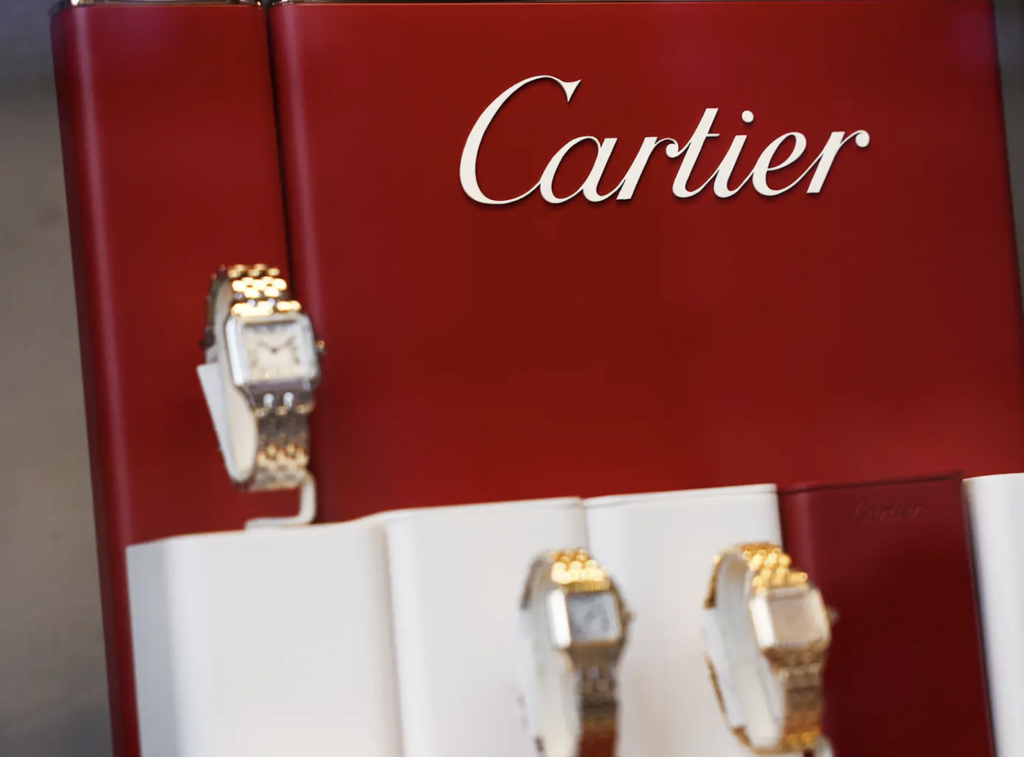
Image credit: Jakub Porzycki/NurPhoto, 2025
Few heritage houses have been able to connect classic craftsmanship with modern desirability as Cartier has in an age when digital-first luxury consumers are the norm. Cartier used to be known for its royal elegance, but it’s becoming popular again: this time with Gen Z collectors. Business Insider (2025) reports that data from the used-luxury-watch market shows that young people are really into Cartier watches right now. The appeal lies in the unique combination of vintage and archive-driven styles that dominate social media, and the Parisian maison’s classic designs. These designs, with their timeless elegance, are becoming popular again with younger, more tech-savvy customers who appreciate the craftsmanship and wear them on their wrists and in their wardrobes.
The House of Cartier: A Legacy in Motion
Louis-François Cartier started Cartier in Paris in 1847. It quickly became known as the “jeweler of kings and the king of jewelers.” For almost two hundred years, Cartier was known for its innovation and refinement. They made everything from royal commissions for tiaras and ceremonial jewels to the first wristwatches. Some of its most famous works are:
• The Santos (1904): One of the first wristwatches ever made, it was crafted for aviator Alberto Santos-Dumont, a testament to Cartier’s timeless appeal.
• The Tank (1917): Based on World War I tanks, it became a design icon that many people, from Jackie Kennedy to Timothée Chalamet, wore.
• The Panthère de Cartier (1914): A bold design that is still a big part of Cartier’s jewelry identity and stands for independence and sophistication.
Cartier has always combined tradition with modernity, using art and storytelling to maintain its high reputation.
The Cartier Comeback: The Vintage Revival and Gen Z
So, why are Gen Z shoppers suddenly interested in Cartier?
The answer is at the crossroads of authenticity, sustainability, and aesthetic storytelling. Gen Z doesn’t care about prominent logos or status symbols like previous generations did. Instead, they value subtlety, craftsmanship, and heritage, which Cartier has in abundance.
The rise of the pre-owned luxury market has further amplified this change. Watchfinder and Chrono24 say that vintage Cartier models like the Tank Must, Panthère, and Santos Galbée are very popular right now. Their simple dials, classic rectangular faces, and art deco shapes are an excellent fit for the “quiet luxury” movement that is popular right now.
Also, Cartier’s presence on social media is low-key but draws people in. The brand’s aesthetic storytelling, delicate cinematography, slow-motion close-ups, and campaigns open to all genders align with modern luxury values of inclusivity and environmental sustainability.
What Cartier Taught Us About Marketing Luxury Jewellery
Cartier’s recent comeback shows how heritage brands can stay relevant without losing what makes them special.
1. Reinventing through Heritage: Instead of following trends, Cartier looks back at its past. The Tank Must collection’s relaunch with environmentally friendly solar movements is an excellent example of classic design meeting modern technology.
2. Subtle Storytelling Instead of Overt Branding: Modern customers want to feel something instead of being sold to. From Love Is All (2021) to Tank Stories (2023), Cartier’s ads focus on mood, romance, and art. This shows that luxury is an experience, not a product.
3. Sustainability and Ethical Luxury: Cartier’s collaboration with the Watch & Jewellery Initiative 2030 and its environmentally conscious sourcing of gold and diamonds reassure customers of its commitment to responsible luxury, a key draw for Gen Z.
4. Digital Elegance, Not Digital Noise: Cartier’s online presence, characterised by its classy and cinematic approach and minimal reliance on influencers, sets it apart from louder competitors and appeals to those seeking authenticity in a digital world.
Cartier as an Example of Timeless Strategy
Cartier’s ability to combine old and new shows that it really understands strategic timelessness. The brand never changes its DNA; instead, it uses new situations to give it a new meaning. Marketing experts call this “heritage fluidity”: preserving the value of the past while adapting to new audiences and technologies. This is a rule that works for many successful luxury brands, such as Hermès, which combines traditional craftsmanship with experiential retail (like its HermèsFit pop-ups).
• Bulgari, which links jewelry and movies through storytelling partnerships with film festivals.
• Tiffany & Co. is back in the spotlight thanks to partnerships with pop culture, like its work with Netflix on Frankenstein.
Cartier’s plan shows that to be a leader in modern luxury, you need to understand culture and be creative.
FROM BOUTIQUES TO BLOCKCHAIN: The New Frontiers of Jewellery Marketing
Jewellery marketing today goes beyond traditional stores to include digital ecosystems and experiential campaigns. Cartier and other companies are looking into virtual stores, AR try-ons, and blockchain certificates of authenticity. These are ways to combine art and technology to create trust-based exclusivity. In the future, owning a Cartier may not just mean wearing a watch; it may also mean having a digital record of its history, craftsmanship, and sustainability, stored on the blockchain and shared through digital storytelling.
A Lesson for Marketers That Will Last Forever
Cartier’s success shows that in the world of luxury marketing, being real is the new currency. People don’t just want beauty or status anymore; they want things that align with their values, tastes, and lifestyle goals. The most important thing is not to change who you are as a brand, but to showcase your history in ways people of all ages can relate to. Cartier has mastered this, and by doing so, it has solidified its place in the future of luxury culture as well as in the history of jewellery.
Where Raffles Makes Luxury Leaders of the Future
We believe in training future leaders who can combine creativity with strategic thinking, just like Cartier’s marketers and brand architects do.
We don’t just teach marketing at Raffles. We train brand visionaries who can take old ideas and make them new.
Arman POUREISA
Marketing Manager
References
Business Insider. (2025, October 25). Cartier watches are having a moment with Gen Z, new pre-owned watch data shows. Retrieved from https://www.businessinsider.com/cartier-watches-winning-gen-z-shoppers-pre-owned-watch-data-2025-10
Jakub Porzycki/NurPhoto. (2025). Cartier watches can go for well over $10,000 on the primary and secondary markets. Business Insider.
Kapferer, J. N., & Bastien, V. (2024). The luxury strategy: Break the rules of marketing to build luxury brands (3rd ed.). Kogan Page.
McKinsey & Company. (2025). The State of Fashion: Luxury Reimagined.
WARC. (2025). Next-gen luxury consumers: The influence of Gen Z on brand heritage and storytelling.







